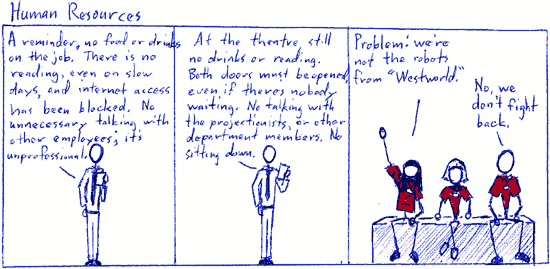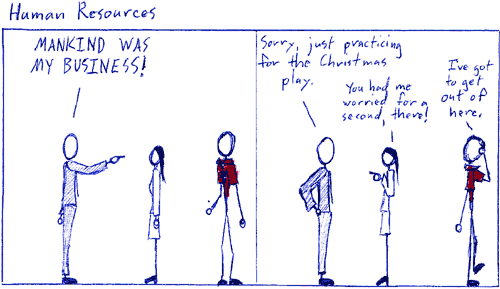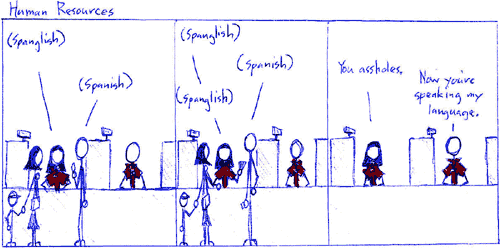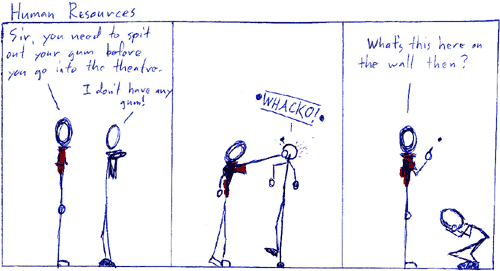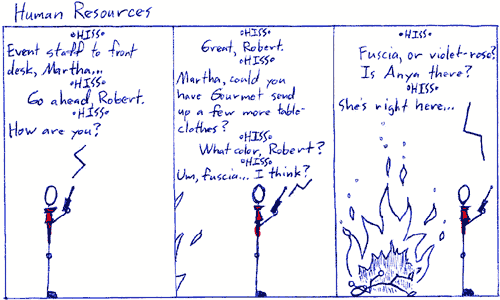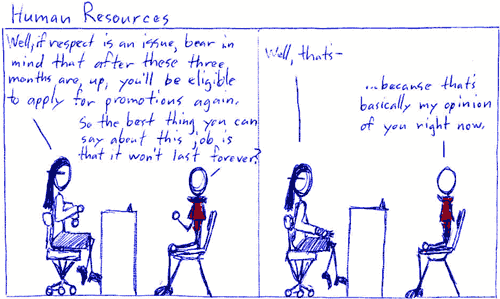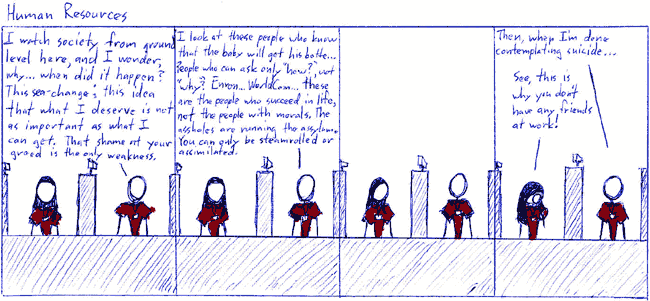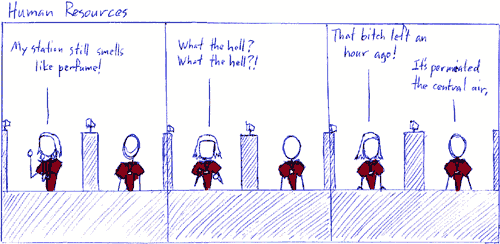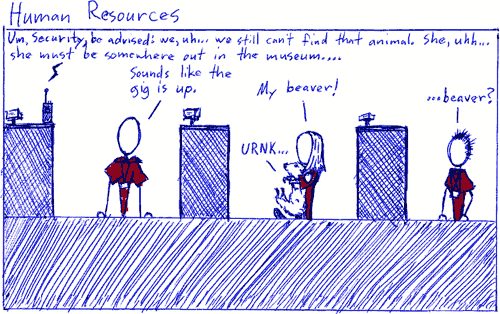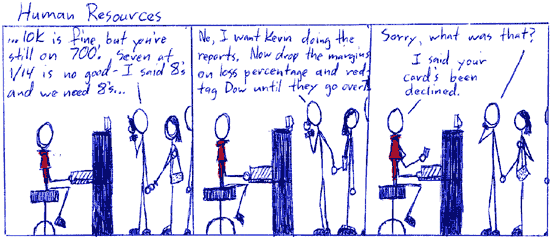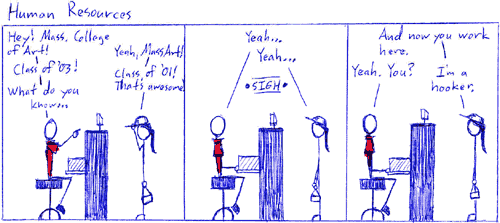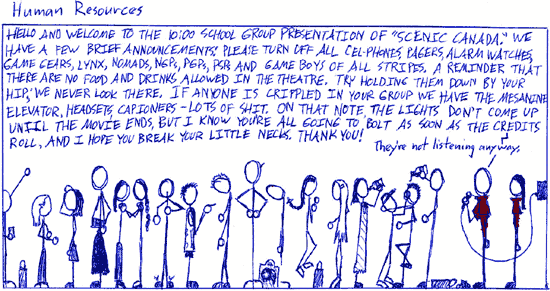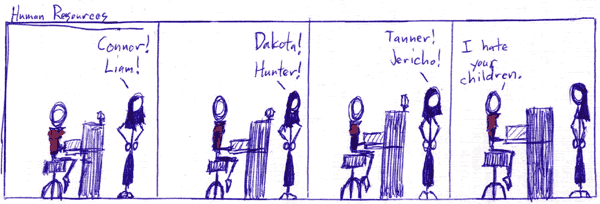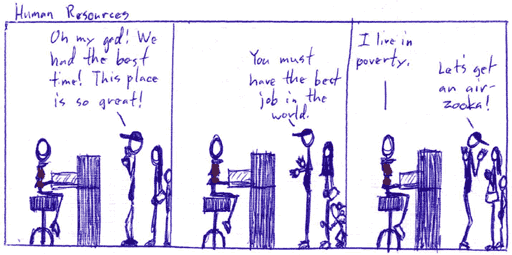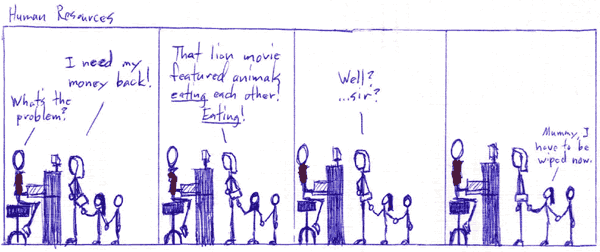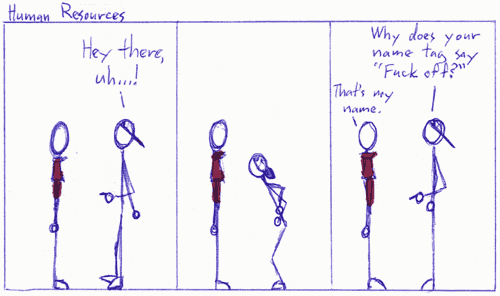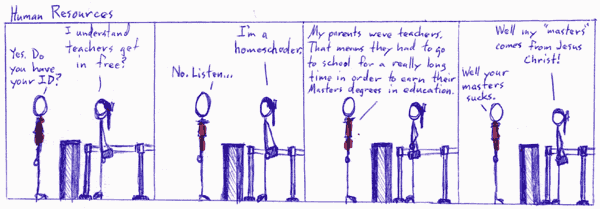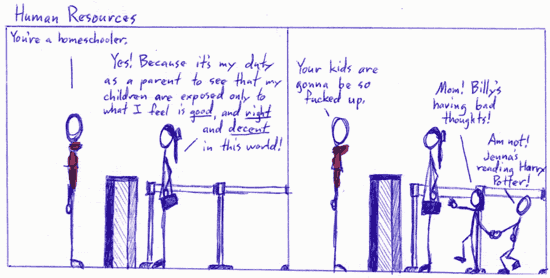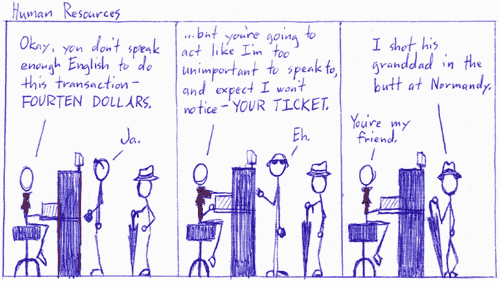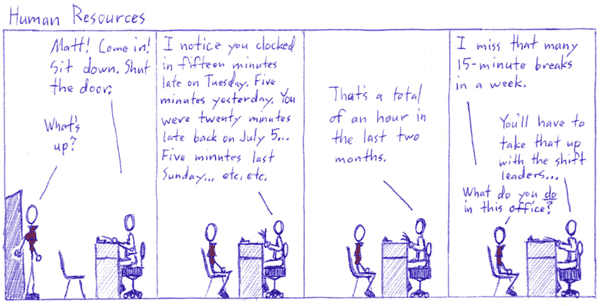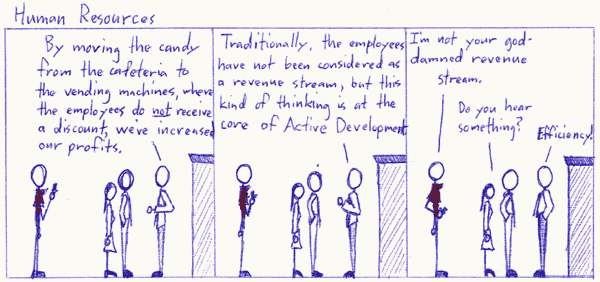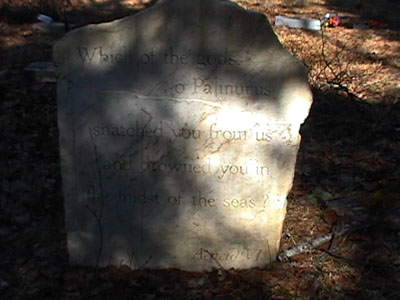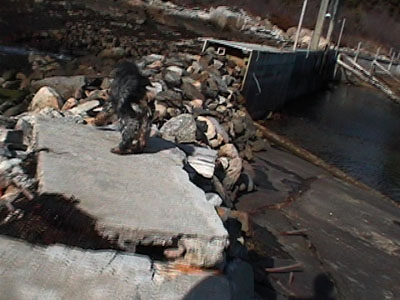Scene 0:
[Fade in on the intercom. ]
THE PRINCIPLE’S VOICE: …should not have happened. And finally, on this class day, our congratulations go out to Mr. Goomba’s automotive class, who successfully took apart Financial Administrator Johnson’s Ford pickup yesterday and reassembled it on the roof. The administrators then responded by car-bombing Mr. Pickford’s new Pontiac outside of his science class, in turn causing the front office to be mail-bombed by the teachers, resulting in a slew of gunshots fired into the teachers’ office, which set events in motion which resulted in the bombing of my house, to be responded to with a strong letter. Also, the chess team will be meeting after school, and Mr. Horovitz reports that the nuclear reactor in the science lab is almost operational. That is all.
Scene 1
[By he doors to the main entrance of the school, the lone figure of PARKS stands. He has a pack on his back, and prefferably a pith helmet. ]
ANNOUNCER: [The voice of adventure, rather stuffy, perhaps British. ] …And so our hero, Sir Walter Parks Raleigh, 11th grader and captain of the chess team, sets out on an arduous journey. He must, at all costs, find the man who raped his hamster, Fluffy, and return before third period. [Quick cut to the hamster in question. ] Fluffy is said to be recovering nicely, though he hasn’t touched his food for most of the day. [Back to PARKS. ] With this in mind, our intrepid hero leaves behind the sweet confines of civilization, and goes off into destiny.
[As he walks off down the hallway, a paper airplane flys past the back of his head. A brief montage of innovative shots, many dramatic and slow-motion, of PARKS walking follows, overscored by dramatic music. At the end, PARKS stops and looks up. A shot, similar or identical to one of the first shots follows, revealing that he has travelled all of ten feet. ]
ANNOUNCER: Our hero realizes that this journey may become even more arduous than he at first assumed, and heads off for snacks. [PARKS turns and goes into the cafeteria. ]
Scene 2
[At the vending machines in the cafeteria. Parks enters, trying to crumple a bill into machine-usable condition. Three or four students appear from between or behind the machines, or off-camera, and waylay him. Some have spears and shorts, others guns, dark shades, and white tee-shirts. They carry him offscreen. The announcer’s voice continues underneath. ]
ANNOUNCER: He is then waylaid by giant Pigmies and 1950’s Cuban Communist revolutionaries.
Scene 3:
[PARKS is dragged by a Cuban revolutionary and a pygmy, fighting unsuccessfully, deeper into the cafeteria. He stops, and his eyes bug out. ]
PARKS: You!
[Reversal to the Cuban Communist revolutionary leader in a heavy khaki shirt and dark shades sitting, fingers crossed, at a folding table, flanked by his men. His men are in similar dress, and are all quite a lot bigger than he. ]
LEADER: So, we meet again. [Evil laugh. His men catch on after he is done that they should have been evil-laughing too and do so, but quickly stop. ]
[Back to PARKS, etc. ]
PARKS: But… but you’re the hall monitors-! What is this-? Why are you doing this-?! Where did these pygmies come from?!?
[Several characters, in turn, in close-up say: “Pygmies?” The pygmies then look at each other, scream, and run away. ]
ANNOUNCER: The pygmies are terrified of themselves, scream, and run away.
LEADER: Now then, getting down to business… You have been charged with trespassing on the lands of the independant state of Ezbulistan, founded at around 8:30 this morning, and extending from approximately over there, to about where ever else we want it. These charges being true, you must be executed. But first, [Addressing the seated spectators. ] any old business? No? Any new business? Very well. Comments from the public?
AN OLD MAN: Yes, I’d like a sewage system.
LEADER: No.
[Random requests from all over the school, such as… ]
MAN WITH A TOWEL AND SHOWER CAP STANDING OUTSIDE THE BOYS’ BATHROOM: I want a sauna.
JOCK STUFFING A FRESHMAN INTO A LOCKER: I want bigger lockers.
GIRL: I want a man.
BOY: I want a man.
TWO INTERPRETIVE DANCERS: We want… love! [At which point they are trampled by the giant pygmies in their desperate attempt to flee. ]
BOY: I want powdered wigs to come back.
BOY DRESSED IN A GIRLS’ CHEERLEADING OUTFIT: [Becoming suddenly self-conscious. ] …no, I’m fine.
–
LEADER: Very well, we shall begin the trial. Do I think you’re guilty?
PARKS: Yes.
LEADER: Then you are. Guilty as charged!
[All the previous “request” people gasp in sequence, including the interpretive dancers who the pygmies then trample again, coming the other way. ]
LEADER: [Laughs his evil laugh. ]
[The head of the Ezbulistan Department of Tourism then interrupts. He is wearing a sport coat and carries a hand microphone. He has his own light. He seems out of breath throughout, as if trying to keep up with the camera. In every cut, he has to get back into the shot. Nevertheless, he tries to put the best spin on things. ]
TOURISM: But, before we head over to the execution, I wonder if we might – take a moment to examine the many natural and artifical wonders – that greet you on a wonderous Ezbulistan vacation…
Scene 4
[A “Wet Floor” sign, by a puddle of water. TOURISM enters quickly. ]
TOURISM: See – the many rivers and streams of Ezbulistan’s national waterways.
Scene 5:
[By a potted plant. ]
TOURISM: – Thrill to our National Forest.
Scene 6:
[Two people play at a pingpong table. ]
TOURISM: For the sports enthusiast, Ezbulistan features a multitude of recreational outlets – and sporting clubs.
Scene 8:
[A single saxophonist butchers a few notes to a radio playing softly behind him. ]
TOURISM: Enjoy an evening with our national band.
Scene 9:
[A shot that shows most of the cafeteria. ]
TOURISM: [walking ] Yes, Ezbulistan; truly a vacational treasure. [Some smiling people join him from behind. ] And now, back to the exciting execution of the first foreigner to enter our country.
Scene 10:
[Low angle shot. Inside the auxilary gym. A bit of wind ruffles PARKS’s hair, accompanied by a more substantial sound effect. He stands proudly, arms tied behind his back, awaiting the inevitable. Shot widens to show his executioners – armed revolutionaries, ceremonially preparing to push him off the precipice. Wider shot for a moment, revealing that the drop off the bleachers is none-too-far, and cushioned at the bottom. ]
EZBULISTANIAN 1: You are charged with crimes against things.
EZBULISTANIAN 2: Yeah.
PARKS: So be it.
Scene 11:
[The desk with the LEADER and high officials of Ezbulistan. ]
Announcer: Meanwhile, a coup d’etat is underway in the state of Ezbulistan.
[A rubber chicken flops onto the desk before the LEADER and his high officials. They regard it with curiousity. Suddenly, it explodes (digitally). Afterward, the table is empty, the pygmies run on, cheering, and assume power by sitting down. ]
Scene 12:
[Back to the execution. ]
EZBULISTANIAN 1: Have you any last words?
[PARKS looks on nobly, and then looks startled, camera fast zooming-in on his face. ]
PARKS: You!
[Fast zoom on a lone, evil figure in the corner. The EVIL MAN chuckles. ]
PARKS: Wait! [But he is pushed off. The drop takes an excessive amount of time, the sound track, in fact, seeming to be paused while the men watch him fall. And they watch him. And they watch him. Just at the last possible funny moment, we hear him hit the mat (far) below. ]
Scene 13:
[A grainy, slow digital zoom on the rodent. A new, stuffy, but tension-filled announcer quickly voices-over. ]
ANNOUNCER 2: This is the story of one rodent’s courageous battle against the confining confines of society. Of what one hamster can be forced to do when no-one else is in its corner. A story beyond boundaries! A story of high drama! A story of sin and more sin, of love/hate/joy/lust/perversity, and above all, a devout lack of pygmies.
Scene 14:
[An on-the-floor, wide angle shot looking up, somewhere in the hallway. The EVIL MAN enters, and looks down at a spot on the floor just in front of the camera. ]
EVIL MAN: [sneering ] So… it’s you. Back again, are you..? What’s that behind you? [A standard revolver rises into the shot, just in front of the camera. ] Oh I see… You haven’t got the guts, though. You… a simple hamster, you haven’t got the guts!
[The gun fires. EVIL MAN falls out of the shot, dead. The gun looks suddenly to the right. ]
SCIENCE TEACHER’S VOICE: No no, not yet!!!
[A nuclear blast rips across the frame from right. Cut, briefly, to a shot of a nuclear mushroom cloud. ]
Scene 15:
[Somewhere in the school. ]
TOURISM: And so ends – our exciting story. Brought to you by the Ezbulistan Department of Tourism. Who would like to remind old friends and new that –
[A rubber chicken flops onto the floor in front of him. He looks at it. Quick cut to an exterior explosion shot, such as the federal building in the X-Files movie. ]
Credits:
[PARKS lying motionless, face down on the mat. He remains there, motionless, all through the excesively long credits. Finally, after the last title has scrolled off the screen, he raises a hand. ]
PARKS: [muffled ] I’m fine.

